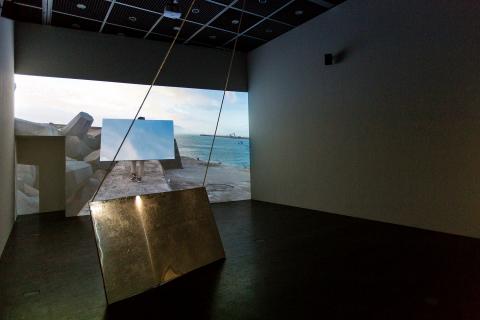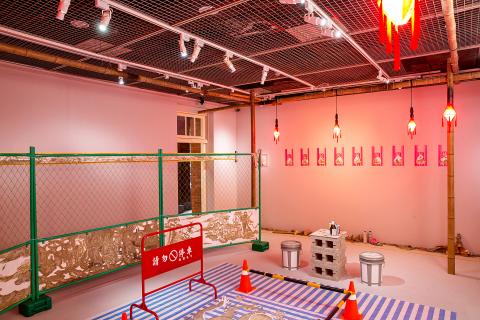Wang Yu-song’s (王煜松) multimedia project, Hualien White Lighthouse (花蓮白燈塔), is inspired by a lighthouse in his hometown that he had read about, but never seen.
As the lighthouse is said to have been blasted apart during expansion plans for the Hualien harbor, Wang set off on a metaphorical journey by carrying a steel piece around the lighthouse’s historical location in search of remnants that may have survived in the nearby waters.
A video documentation of Wang’s journey is screened as a giant projection, accompanied by the slightly worn and scratched steel plate that reflects ripples of light onto the empty back wall.

Photo Courtesy of Taipei Fine Art Museum
Wu won this year’s Taipei Art Award with the project, for which the results were announced on Nov. 23.
Organized by the Taipei City Government Department of Culture Affairs, the awards is a highly-regarded national competition for contemporary art. Judged by a jury panel of six artists, educators and researchers, artists who passed the first screening were then evaluated by their exhibition proposals that, if selected, would take part in a group show of 13 finalists. The exhibition is currently on view at the Museum of Contemporary Art.
As the oldest city-run art award, The Taipei Art Awards has been a platform for artists to gain recognition, opportunity and monetary support. Wang was awarded with NT$550,000 and a solo exhibition at the Taipei Fine Art Museum within the next two years. The five honorable mentions Wu Chi-yu (吳其育), Hung Hsuan (洪瑄), Yao Chung-han (姚仲涵), Chen Liang-hsuan (陳亮璇), and Sun Pei-mao (孫培懋) each received NT$120,000.

Photo Courtesy of Taipei Fine Art Museum
While the award’s mission is to celebrate artistic excellence and foresee art trends that speak to “the spirit of our times,” it must be taken with a grain of salt just how representative of a view a juried process can produce.
Managed by the Taipei Fine Arts Museum since 1983, the awards program has undergone several reforms over the past two decades in order to create a criteria and evaluation process that makes sense to the current art climate.
In 2010, the management team removed the medium-specific award categories of two-dimensional, three-dimensional3 and applied arts to accommodate the growing fluidity of art mediums and cross-disciplinary practices.
In the same year, organizers also added an exhibition component to challenge the artist’s ability to produce their submitted project under site-specific conditions of the museum space. With this move, the awards also became a pressure-cooking challenge for the candidates.
Normally held at Taipei Fine Arts Museum, this year’s Taipei Art Awards exhibition is hosted by the Museum of Contemporary Art due to ongoing renovations at the former site. The exhibition is an eclectic mix of artistic endeavors, many of which resonate closely with the pulse of contemporary Taiwan— its collective memories and histories, folk culture and traditions, and modern lifestyle enmeshed in computer technology Because of these relatable themes that tie the exhibition closely to local culture and everyday life, the show reads as a well-curated, collective vision of the world today.
Yuki Pan (潘小雪), director of Museum of Contemporary Art, says that the exhibition features artists who use contemporary art means to tell “epic poems of contemporary times, tragedies of everyday life, the meandering journey of life, and rituals of modern technology.”
Honorable mention Hung Hsuan’s (洪瑄) Gong Di Ju (工地居) is an intricate installation styled with a mashup between fine literati art and construction site culture.
The project title is a phonetic spinoff of Gong Di Ju (供帝居), a room traditionally reserved to showcase the emperor’s collection of curiosities. In Hung’s work, a line of yellow warning tape is painted over with an emulation of the celebrated National Palace Museum’s Along the River during the Qingming Festival (清明上河圖).
A barbed-wire fence is covered with landscape scenes and celestial beings. Betel nut packages printed with seductive images of woman are redressed with illustrations of flowing traditional dresses. These makeovers on ordinary construction site objects create a surreal dialogue between intellectual, scholarly aesthetics and grassroots labor culture.
■ The Taipei Art Awards exhibition will be on view until Feb. 4 at the Museum of Contemporary Art, Taipei (台北當代藝術館, MOCA, Taipei), 39 Changan W Rd, Taipei City (台北市長安西路39號). Visitors of the exhibition are also given the opportunity to take part in the voting of the Audience’s Choice Award, which will be announced on Jan. 29.

In the March 9 edition of the Taipei Times a piece by Ninon Godefroy ran with the headine “The quiet, gentle rhythm of Taiwan.” It started with the line “Taiwan is a small, humble place. There is no Eiffel Tower, no pyramids — no singular attraction that draws the world’s attention.” I laughed out loud at that. This was out of no disrespect for the author or the piece, which made some interesting analogies and good points about how both Din Tai Fung’s and Taiwan Semiconductor Manufacturing Co’s (TSMC, 台積電) meticulous attention to detail and quality are not quite up to

April 21 to April 27 Hsieh Er’s (謝娥) political fortunes were rising fast after she got out of jail and joined the Chinese Nationalist Party (KMT) in December 1945. Not only did she hold key positions in various committees, she was elected the only woman on the Taipei City Council and headed to Nanjing in 1946 as the sole Taiwanese female representative to the National Constituent Assembly. With the support of first lady Soong May-ling (宋美齡), she started the Taipei Women’s Association and Taiwan Provincial Women’s Association, where she

Chinese Nationalist Party (KMT) Chairman Eric Chu (朱立倫) hatched a bold plan to charge forward and seize the initiative when he held a protest in front of the Taipei City Prosecutors’ Office. Though risky, because illegal, its success would help tackle at least six problems facing both himself and the KMT. What he did not see coming was Taipei Mayor Chiang Wan-an (將萬安) tripping him up out of the gate. In spite of Chu being the most consequential and successful KMT chairman since the early 2010s — arguably saving the party from financial ruin and restoring its electoral viability —

It is one of the more remarkable facts of Taiwan history that it was never occupied or claimed by any of the numerous kingdoms of southern China — Han or otherwise — that lay just across the water from it. None of their brilliant ministers ever discovered that Taiwan was a “core interest” of the state whose annexation was “inevitable.” As Paul Kua notes in an excellent monograph laying out how the Portuguese gave Taiwan the name “Formosa,” the first Europeans to express an interest in occupying Taiwan were the Spanish. Tonio Andrade in his seminal work, How Taiwan Became Chinese,